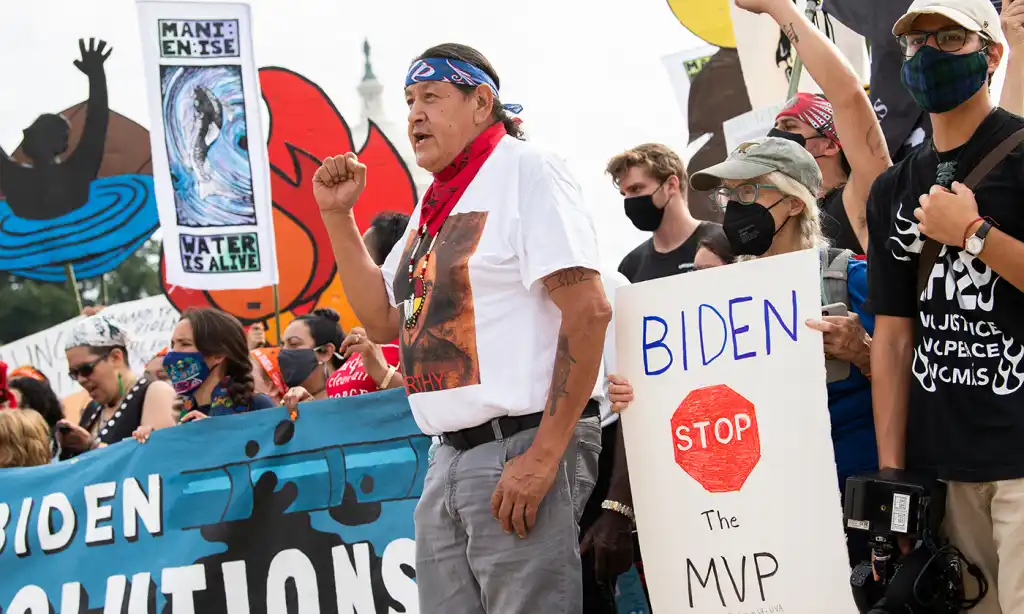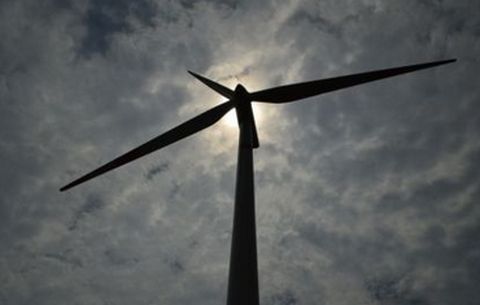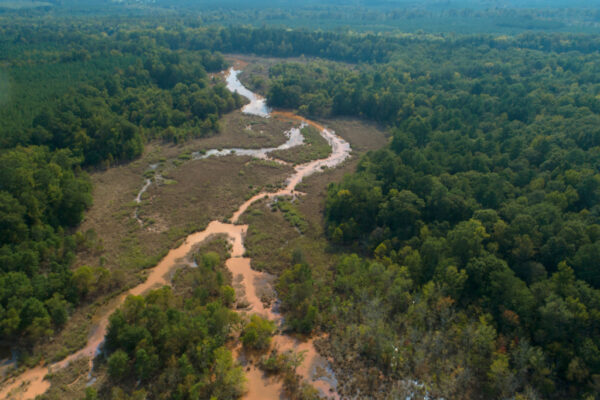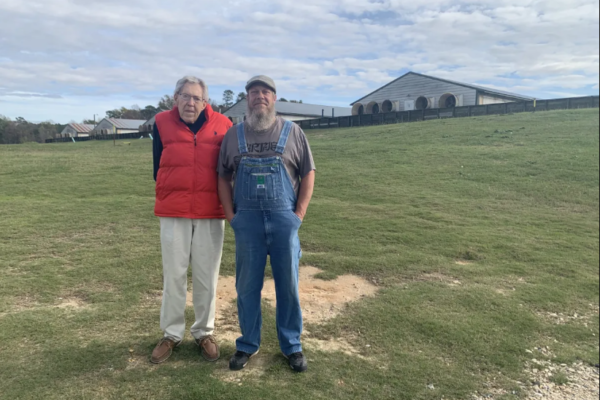By: Ray Levy Uyeda, Yes Magazine
March 24, 2022
Emily Sutton loves the Haw River, with its boulders and whitewater, perfect for rafting. The river’s 110 miles flow through rural North Carolina, touching six counties in the state. But the Haw, which Sutton advocates for as its “riverkeeper” with the Haw River Assembly, is also the backdrop of an ongoing battle against a proposed pipeline, which threatens the health of the river and those who enjoy it.
Plans for the Mountain Valley pipeline were first announced in April 2018. The proposed pipeline would transport fracked gas 300 miles from West Virginia to a compressor site in southern Virginia, and then another 70 miles into northern North Carolina. This last section is called the Mountain Valley Southgate Extension, and it goes through the state to allow a major stakeholder that already services nearly 30% of counties to expand its market. It is this section of the pipeline that would decimate the Haw River.
The pipeline was originally supposed to be completed in less than a year and cost financial partners $3.5 billion. But four years of coordinated cross-state grassroots resistance to the pipeline’s construction has thus far prevented the Mountain Valley pipeline corporation from laying even an inch of pipeline in North Carolina soil. New county, city, and state laws have a far reach in preventing pipelines that are slated to start in one state and end in another, as seen with a Virginia state law that impacts the North Carolina section of the pipeline.
With the project over budget and lacking necessary permits, one financial backer of the Mountain Valley pipeline corporation says it’s reconsidering its 31% investment in the now-$6.2 billion pipeline. The corporation is also facing an $800 million impairment charge—a financial term to describe when the value of a good or service drops below the cost to produce it.
“It was determined that the continued legal and regulatory challenges have resulted in a very low probability of pipeline completion,” the funder said in a U.S. Securities and Exchange Commission filing. That, along with the additional legal and financial hurdles the pipeline now has to overcome, is likely causing other investors to see the project as more of a financial risk, forcing them to reconsider their own stake.
And this cross-state collaboration is only one of many where people power is waging a concerted, and increasingly successful, campaign against fossil fuel corporations and the harmful extraction they promise. Pipeline corporations often rely on silence and intimidation—social ills that splice communities and convince neighbors of their isolation from each other. But organizers in Tennessee, North Carolina, and Nebraska are proving that building collective community power can successfully counter Big Oil’s moneyed interests.
Given that oil extraction in the U.S. increased during the pandemic and that federal officials continue to subsidize fossil fuels despite scientific warnings to stop their sale and combustion, it’s clear to organizers that grassroots strategies are critical to fighting pipelines.
“When a pipeline is proposed, [those impacted] either don’t know about it until it’s too late, or they don’t have the access to the information or time to dedicate to showing up to all of these meetings and giving comments,” Sutton says. When it came to the pipeline threatening the Haw River, though, she says that wasn’t the case: “We really gave the power to the people who are impacted.”
How to stop a pipeline
In many ways, pipeline fighting is a battle between narratives—one of money versus people power—and also one of priorities—economic benefit in the short term versus generations of climate disaster. To understand the impending defeat of Southgate, it’s important to realize that wins against pipelines don’t occur in a vacuum; generational Appalachians in West Virginia have organized in tandem with water defenders and protectors in North Carolina. Organizers from different communities, even in different states, are stronger working together when they have a shared aim.
There’s a blueprint, organizers say, of what to do when a pipeline threatens already vulnerable communities. The first step is to educate neighbors and those who care about the land. The second is to make the building process as legally untenable as possible by advocating for the passage of new city and county laws, demonstrating a pipeline’s fallibility to state environmental agencies.
“It’s hard to fight against major corporations when you don’t have money,” says Crystal Cavaliere, a member of the Occaneechi Band of the Saponi Nation. Cavaliere lives in Mebane, North Carolina, and is one of the main leaders working on the Southgate resistance efforts. She says organizers and impacted residents are made to feel like if they don’t have money, they don’t have power. Cavaliere’s work is to disprove that hypothesis.
There are certainly immediate risks to the river’s ecosystem: rerouting creeks with pipe, sediment pollution from construction, and gas leaks due to breakages in the line. But there’s even more at stake. Within the Haw’s watershed, the Southgate Extension would threaten 207 streams, three ponds, and 9 acres of wetlands, as well as more than 600,000 square feet surrounding a nearby watershed, according to the state Department of Environmental Quality. And these threaten the river’s future as well as its past.
The word haw means “river” in the language of the Sissipahaw, one of the Indigenous tribes that called the region home. “This river was the lifeblood for entire civilizations,” says Sutton, with the Haw River Assembly, the nonprofit dedicated to advocacy and protection of its watershed. English settler-colonizers committed genocide against the Sissipahaw peoples; the river and its name remain a memory of their existence.
The river was also a site of the underground railroad during the period of legal enslavement of African Americans in the United States, according to the Assembly.
Even today, the Haw “still continues to be this connecting source from people in the triad, in Greensboro, all the way down to Jordan Lake and the triangle in North Carolina,” Sutton says.
Fighting for all people, and their river
In late 2021, three years into the battle against the Mountain Valley Southgate Extension, organizers in North Carolina were beginning to lose hope. The state permitting process looked like it was going to allow the beginning stages of pipeline construction, portending an uphill climb of legal challenges for defenders of the Haw River.
But then, in the first week of December, organizers pushed the Virginia Air Pollution Control Board to deny the permit required to build a pipeline compressor station, citing a 2020 Virginia environmental justice law and the potential that the compressor station would contribute to ongoing environmental injustices faced by Black and Brown residents living near the site. The compressor is a key element connecting the mainline of the Mountain Valley pipeline to the extension through North Carolina. This forced the company to start the permitting process all over again and allowed organizers more time to rally impacted residents and lobby public officials.
A month later, in a case brought by the Sierra Club, Appalachian Voices, and other environmental organizations, a federal appeals court overturned permits previously issued by two agencies, the U.S. Forest Service and the Bureau of Land Management, that would have allowed the mainline to devastate two species of endangered fish—the Roanoke logperch and candy darter—that live in the Jefferson National Forest, which straddles the West Virginia–Virginia border.
Moreover, officials in North Carolina have twice denied a necessary Water Quality Certification permit, mandated by the Clean Water Act, to the pipeline company. And as long as the mainline isn’t built, there can be no Southgate Extension.
“Southgate doesn’t have anything to stand on in North Carolina,” Sutton says.
But these wins aren’t the product of state and federal agencies deciding to do the right thing, she says. They’re consequences of years of relationship building and storytelling by communities most likely to bear the brunt of pipeline construction and its ongoing devastation in the form of gas leaks, methane pollution, and water contamination—the critical first step in the blueprint of pipeline resistance.
“You have to stand up, you have to say no, and you got to start telling these people how you feel,” Cavaliere says. By “these people,” she means city and county officials, representatives from the U.S. Army Corps of Engineers, and state agencies and boards tasked with evaluating permits filed by the construction company.
Along with other organizations fighting the extension’s construction, Cavaliere coached landowners and other impacted residents in Virginia, West Virginia, and North Carolina to tell their personal stories in the few minutes allotted for public comment at meetings held by regulatory agencies and commissions charged with handing out permits. Cavaliere says she’s working with tribal leaders and nations that steward land in what’s known as South Carolina to prevent any future plans for pipeline construction.
“We use our traditional Indigenous values when we’re organizing, so it is kind of slow,” Cavaliere says. “It’s just really about gaining people’s trust.”
Learning from successful decades-long battles
While fighting his own pipeline battle in Memphis, Tennessee, organizer Justin J. Pearson spent time in North Carolina with Cavaliere to swap strategies and speak at actions she had organized. From October 2020 through December 2021, Pearson led a grassroots resistance against the construction of the Byhalia Connection pipeline, which would have ravaged the majority-Black neighborhood of East Memphis. The proposed 49-mile pipeline was funded by a subsidiary of Valero and Plains All American Pipeline, billion-dollar corporations with vast legal and economic resources.
Pearson’s efforts focused on the second part of the pipeline resistance blueprint: passing preemptive local laws. “The only way you’re gonna get legislation passed is with people power,” Pearson says, explaining that the legislative process also serves as a means to educate constituents and policymakers who may not know the many threats pipelines pose. “It isn’t enough to get things done; you have to have folks behind it and supportive of it to show politicians that it matters.”
The 2021 passage of legislation protecting drinking water and residents’ homes affirmed that the pipeline’s construction company and financial backers would need the consent and participation of the people of Memphis if they wanted to build. In response, community members helped pass a countywide setback ordinance and two citywide ordinances—one instituting a setback and another protecting the Memphis Sand Aquifer.
In July 2021, the company announced that it was pulling plans for the pipeline, proving Pearson’s community campaign against Byhalia a success.
During this time, the Biden administration also revoked the permit for the Keystone XL pipeline, indicating to Pearson that his ultimate goal might just be attainable after all: “We’re collectively fighting for a future … for people, especially Black, Indigenous, people of color—people who this society has excluded intentionally. We are changing that narrative in the course of history about whose lives are deemed worthy and worth protecting,” Pearson says.
It also helped that Jane Kleeb, one of the faces of the Keystone resistance, called Pearson up early in his resistance work to see how she could support his efforts. Kleeb says she provided some resources, but more importantly, she connected him to a whole community of pipeline fighters—organizers across states who share stories and swap strategies on what Kleeb refers to as “pipeline-fighter calls.”
For nearly a decade, Kleeb fought Keystone by building relationships between groups who, on the surface, might appear to have little in common, like White ranchers and Native peoples. Kleeb learned that pipeline companies follow their own playbook, starting with predatorily approaching landowners and coercing them to sign easement agreements that allow the companies access to their land for drilling or pipeline construction. For instance, companies may tell landowners that all of their neighbors have signed easement agreements and that they’re the last to do so (when in reality no one else has), Kleeb explains, in an attempt to isolate, intimidate, and pressure the landowner to comply.
“The only thing that stops these pipelines is if you lock up the land,” Kleeb says.
Today, the organization built out from the fight against Keystone XL, Bold Alliance, mobilizes communities to fight pipelines in multiple ways, particularly by creating easement action teams. In these teams, groups of landowners are represented by Bold Alliance’s lawyers, who ensure pipeline companies won’t approach or speak to the landowners without legal representation.
“It kind of takes that power that the pipeline companies had of preying on landowners away, and puts some power back into the hands of landowners,” Kleeb says.
Not every pipeline battle leads to a win, Pearson says, nodding to the now-operational section of a tar sands pipeline known as Line 3, which runs through Native land in northern Minnesota. A more local risk is a bill being fast-tracked through the Tennessee state legislature aimed at usurping local control from cities that try to prevent fossil fuel companies from operationalizing. If passed, the legislation would become effective this summer, undoing the work Pearson and others organized so hard for. Yet each successive fight bears lessons, and that’s important, he says.
“Even when we lose some of our fights … there’s something that has happened in our awareness and our attention and our intention and our ability to still fight on,” Pearson says. “The next fight won’t start at the same starting place; it’ll be a little further. The people who are fighting that fight will be a little more ready for the next one.”





